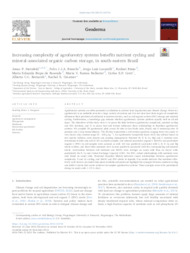Increasing complexity of agroforestry systems benefits nutrient cycling and mineral-associated organic carbon storage, in south-eastern Brazil.
Increasing complexity of agroforestry systems benefits nutrient cycling and mineral-associated organic carbon storage, in south-eastern Brazil.
Author(s): STEINFELD, J. P.; BIANCHI, F. J. J. A.; LOCATELLI, J. L.; RIZZO, R.; RESENDE, M. E. B. DE; BALLESTER, M. V. R.; CERRI, C. E. P.; BERNARDI, A. C. de C.; CREAMER, R. E.
Summary: Agroforestry systems are often promoted as solutions to address land degradation and climate change. However, agroforestry is an umbrella term for a large variety of systems and it is not clear how their degree of complexity influences their provision of soil-based ecosystem services, such as soil organic carbon (SOC) storage and nutrient cycling. Furthermore, a knowledge gap remains whether agroforestry systems perform equally well on all soil types. The objectives of this study were 1) to assess the links between agroforestry complexity, nutrient cycling and SOC fractions, and 2) to assess how soil texture influences these relationships in Brazilian agroforestry systems. We sampled 59 agroforestry plots across 30 sites in Sao Paulo state, Brazil, and 8 monocrop sites (6 pastures and 2 crop monocultures). The 38 sites represented a soil textural gradient, ranging from very sandy to very clayey (clay content range 25 – 620 g kg?1). An Agroforestry Complexity Index (ACI) was defined based on tree species richness, stem density and pruning management. Nutrient (N, P, K, Ca, Mg) and C contents were determined in litter and soil (0–30 cm depth) samples, and mineral-associated organic C (MAOC) and particulate organic C (POC) in soil samples were assessed as well. ACI was positively associated with C, N, P, Ca and Mg stocks in litter, and these litter nutrients were in turn positively associated with the corresponding soil nutrient stocks. Associations between soil nutrients and MAOC were stronger on sandy soils than on clayey soils, particularly for P, Ca and Cation Exchange Capacity (CEC). For POC, robust relationships with nutrients were only found on sandy soils. Structural Equation Models indicated causal relationships between agroforestry complexity, P and Ca cycling, and MAOC and POC stocks in topsoils. Our results indicate that nutrients effectively cycle from in situ mulch into plant-available soil pools and highlight the synergies between nutrient cycling and stable C stocks that can be achieved in complex agroforestry systems. These synergies seem to be particularly strong on sandy soils (<15 % clay).
Publication year: 2023
Types of publication: Journal article
Observation
Some of Embrapa's publications are published as ePub files. To read them, use or download one of the following free software options to your computer or mobile device. Android: Google Play Books; IOS: iBooks; Windows and Linux: Calibre.
Access other publications
Access the Agricultural Research Database (BDPA) to consult Embrapa's full library collection and records.
Visit Embrapa Bookstore to purchase books and other publications sold by Embrapa.

